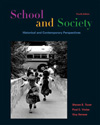 |  School and Society: Historical and Contemporary Perspectives, 4/e Stephen E. Tozer,
The University of Illinois, Chicago
Paul C. Violas
Guy Senese,
Northern Arizona University
Social Diversity and Differentiated Schooling: The Progressive Era
Learning ObjectivesAmong the objectives that Chapter 4 seeks to achieve are these:
| Students should understand and be able to evaluate the massive shifts in political economy, ideology, and schooling that took place at the dawn of the twentieth century. |
 |  |  | | Students should develop a deeper and broader base from which to evaluate the history of racial and ethnic prejudice in the United States. They should be able to compare progressive educational responses to ethnic differences with the responses to Irish Americans identified in Chapter 3 and, later, with the responses to African Americans to be identified in Chapter 6. |
 |  |  | | Students should be able to assess the degree to which scientific management in the industrial workplace served the interests of workers and was or was not consistent with democratic ideals. They should also be able to assess whether progressive social reform was consistent with democratic ideals. |
 |  |  | | Students should be able to evaluate the degree to which modern liberal ideology was consistent with specifically articulated conceptions of democracy, such as Jeffersonian participatory democracy or Dewey's developmental democracy. |
 |  |  | | Students should see the degree to which domestic social order was achieved by the exercise of the force of arms and by political and economic control of schooling, thus calling into question a "consensus" theory of social order. |
 |  |  | | Students should be able to distinguish among different strands of progressive education and be able to evaluate the interests served by these different camps. |
 |  |  | | Finally, students should be able to evaluate the degree to which all population groups of students were-or were not-equally well served by the four progressive educational aims of social stability, employable skills, equal educational opportunity, and meritocracy. |
|



 2002 McGraw-Hill Higher Education
2002 McGraw-Hill Higher Education